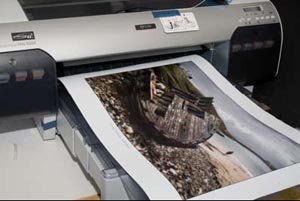articles/Review/epsonstyluspro4880-page4
EPSON Stylus Pro 4880 - part 4 of 1 2 3 4
by Mike McNamee Published 01/12/2007

The measured metamerism was slightly higher than anticipated at 2.2 ΔE Lab (D65 to Tungsten at 50% grey) and we went back to the sample to investigate. What we found was that the slight yellow bias was lifting the metamerism value. The cooler swatches in our grey-seeker part of the audit image were the typical values between 1.1 and 1.5 ΔE Lab. As shown in the graphic, the higher values were obtained on the yellow-bias side of the print.
As always we made large prints to get an impression of the printer's capabilities.
Advanced Black and White
No changes seems to have been made to the Advanced Black and White driver. If the settings are zeroed the prints still come out about 11% too light and our previously reported settings tweaks of -11% density and +6% on contrast still hold, certainly as starting off points. Using ABW, the image tone was mapped closely to the coolness of the paper and the metamerism values were back down to the 'normal' values we expect from UltraChrome.

Overall
The changes between the 4800 and 4880 printers are not visible from the outside of the machine. However, the ink changes are a measurable improvement from an already high benchmark. The productivity improvement is substantial and would make quite a difference if you were printing a wedding album. The ABW interface and the inability to fast change the inks from Matte to Photo Blacks are a little disappointing and must surely be under consideration for a future upgrade. If you already own a 4800, and you are coping with the print speed, it is unlikely to be worthwhile changing up. However, for proofing, the increased speed and greater reach of the gamut are very welcome. So if you are new into the market, the 4880 remains at the top of the wish list in the 24 inch category.
Please Note:
There is more than one page for this Article.
You are currently on page 4
- EPSON Stylus Pro 4880 page 1
- EPSON Stylus Pro 4880 page 2
- EPSON Stylus Pro 4880 page 3
- EPSON Stylus Pro 4880 page 4
1st Published 01/12/2007
last update 09/12/2022 14:54:00
More Review Articles
There are 0 days to get ready for The Society of Photographers Convention and Trade Show at The Novotel London West, Hammersmith ...
which starts on Wednesday 15th January 2025





